
“So…the diaphragm is a muscle?” a student epiphonied during one of my beginning yoga sessions. “Yes!” I said with the same glee a mom has when her baby takes that first step. “Just like your biceps. You gotta stretch it and strengthen it.” We’d been working on Bridge lifts to Udiyanna Bandha and his new understanding of this muscle changed how he viewed “core” work, bike riding, and how he breathed in everyday life. Way cool.
I can live without a biceps. I can live without the giant quadriceps on the front of my thigh. I can even live without the overworked chewing muscle called the masseter who does the most work for its size of any muscle in the body. But, I cannot — repeat, cannot — live without a diaphragm.
When it stops flexing, air stops moving. After four minutes of that, pieces of the brain start to die. Folks who bravely survive muscular dystrophy — a genetic disease in which muscle fibers are unusually susceptible to damage and become progressively weaker — eventually pass away because of the failure of the diaphragm. When snake venom paralyzes all the muscles of the victim, suffocation is the cause of death because the diaphragm, too, is paralyzed.
Without even noticing, we breathe on average 20,000 times per day. That’s over 8 million breaths per year. Hold up. That’s huge! If we really got it, folks wouldn’t come to yoga class complaining about tight hamstrings and wanting to touch their toes, they’d say, “Can you help me stretch my diaphragm? I want to breathe more efficiently so I can live longer. ”
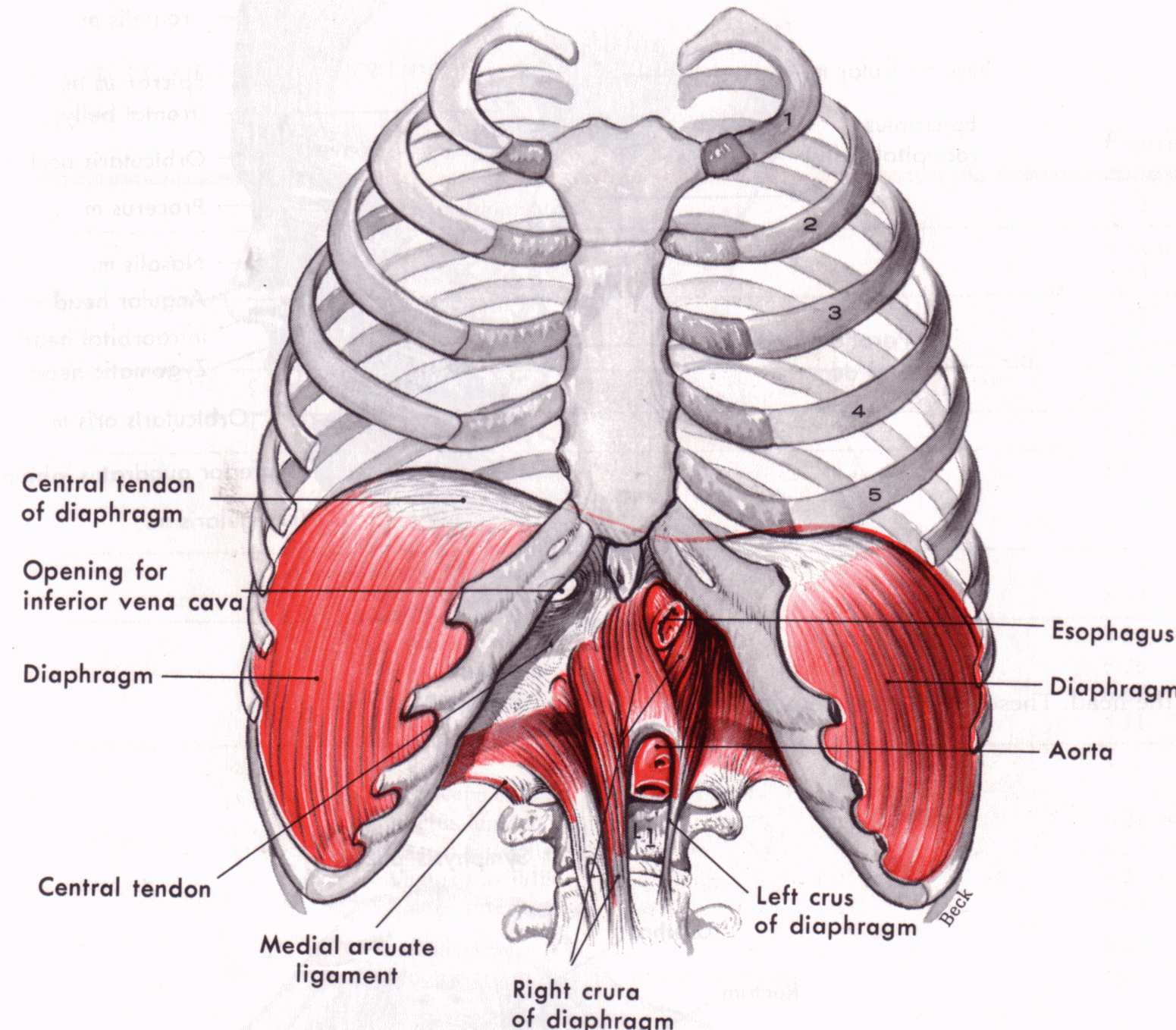
But don’t just limit our breathing buddy to breath. The diaphragm is like a border crossing for three important highways: the aorta, the largest artery (think garden hose) in the body from which most of your vital organs receive blood; the inferior vena cava which is the return-route back to the heart for deoxygenated blood; and the esophagus, your food and breath tube. It’s also the border crossing for the phrenic nerve which is responsible for telling us to “chill out!” Sewn to the fibrous linings around the heart and lungs, the diaphragm takes some shape from above because of the heart and lungs and from below because of its intimate rest atop the liver, stomach, spleen, and transverse colon.
If it’s tight, weak, or unable to move freely, you think that’ll effect stress? circulation throughout the body? Our emotions? Digestion? And that’s not all.
Because of its centrality (pasted to the inner surface of half your ribcage), it’s a key structural player in spinal stability. “Improving the breath’s agility goes hand-in-hand with your postural ability,” describes Jill Miller in an interview for this core webinar. It bisects us bipeds and “suture[s] into and seam[s] into” the major fascia, muscle, and tendons that line the abdominal and thorasic cavities, acting as a buttress for this “soft tissue canister.”
If we got all this, folks would come to yoga class saying things like, “Bikini season is coming up and I want a strong foundation for my six-pack. I figured i’d try yoga to get my diaphragm ripped,” or “I have lower back pain, and my body worker sent me here to build up my diaphragm,” or “I’m trying to add a third register to my singing voice and need some tools.”
So how do we stretch, strengthen, and assure proper movement of this muscle?
Embody it; drawing and feeling from deep to surface; talking to all the muscles having intimate relations with the the diaphragm. Start building the embody map using abdominal massage with the Yoga Tune Up® Coregeous Ball, as demonstrated below by Jill and Dr. Kelly Starrett of MobilityWod. “The four abdominal muscles [which] wrap the entire abdomen in vertical, horizontal and diagonal directions, in the same way packing tape is wrapped around a box going for a long journey. ” [Biel, Trail Guide to the Body 5th ed., p.209] These layers need to show their love with tight embraces but also to let go and give space if the diaphragm wants to stretch.
Learn about the YTU At Home Program
Watch the QuickFix Online Videos



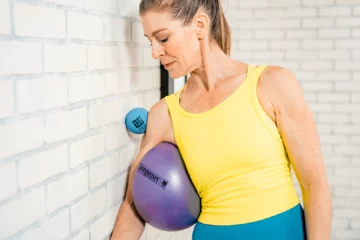

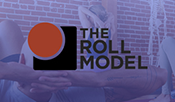
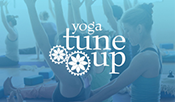


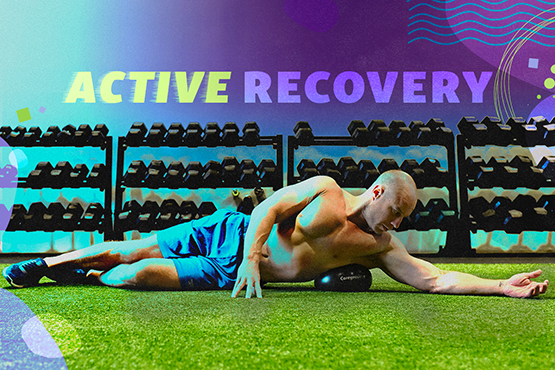
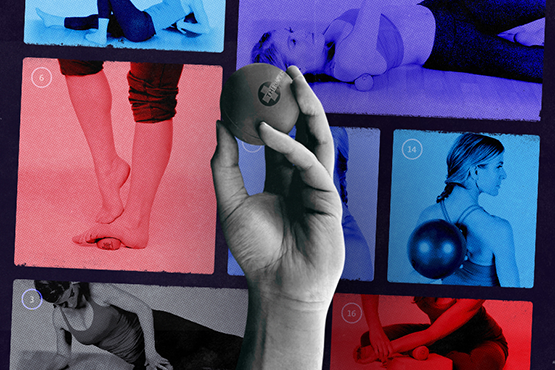
Having had surgery to a ligament on my diaphragm, I found your blog post very interesting. I’ve had a strange relationship with this muscle my whole life. The pain I had in that area made it almost impossible to study it – I couldn’t roll it or touch it and it was hard to think about it. Since my surgery, I’ve wanted to study the diaphragm and your blog post is giving me a starting point. Thank you!
We give so much attention to the back body (our upper shoulders, back of the neck, lower back, and hamstrings) and forget that so much of the tension we feel in our back is a RESULT of the tension in the front body. Thanks for shedding light on the importance of releasing our abdomen and diaphragm in order to free the whole.
I loved this article on the diaphragm! I actually had this moment much more recently than I’d like to admit–I’d known about the diaphragm forever because I’d taken singing lessons when I was a child and teenager AND taken many workshops on the psoas but it never occurred to me that it was a muscle until it was very explicitly pointed out! I also have to admit that more recently I’ve thought of releasing the diaphragm because of the osteo work that I’ve done. But I hadn’t thought about strengthening it and training it like a muscle. Or that it was literally keeping us alive. Thank you.
Great article. I’m really gaining a better appreciation for this oft under-appreciated muscle and it’s connections to other parts of the body.
I’ve just started using the Yoga Tune Up Balls and I was curious how and why the Coregeous Ball can be used. After reading the blog and watching the video I’m more informed, and I’m going to buy one tomorrow!
I remember when this moment happened in my life. My mind was blown when Lisa Hebert brought my attention to the diaphragm by introducing me to the Coregeous ball and Uddiyana Bandha. I never thought of it, or the lungs, as a muscle. In dance breathing efficiently is so important in so many ways. Its not just about endurance. In contemporary dance it is a way to cue each other, communicate with one another, it helps us to inform our bodies and it works cooperatively with our muscles and nervous system to produce a desired effect. But we often do not value breath enough in our everyday lives. As soon as I step out of the studio, I lose my poise, my presence. I would like to change my intentions in my practice and become more mindful of my diaphragm and its functions and integrate it into my everyday activities outside the studio. My next step after finishing the Level 1 Tune Up Training with Lisa Hebert and Mimi Martel in Gatineau is to take the Core component of the Tune Up trainings and I can’t wait. Thanks for reminding me about how important this muscle is Louis.
I am just getting started in my explorations of the diaphragm and it is so exciting. I have already noticed fewer headaches and a decrease in that feeling that I just can’t suck enough air into my lungs which invariably leads to anxiety. I don’t know if my body tension was creating my mental tension or vice versa but what I do know i that the Coregeous ball was the best investment in my physical and mental health. I still have a long way to go for my EmbodyMap, but I’m excited to do it!
I love this! I am completing my YTU level 1 training and, in my other life, a professional tuba player and I am forced to admit after all these years of playing and teaching tuba that I don’t really understand the diaphragm. Aside from being clear and entertaining, this post is a rallying call for us all to give the diaphragm the love and respect it deserves. Thank you!
Beautifully written. I would love to add that being connected to your diaphragm and taking care of it properly is also key to “getting your core back” after pregnancy and avoiding “core amnesia” (pretty common after pregnancy). You might not be able to do much once you have popped out a baby but you can breathe intentionally even if you are resting in bed.
Great article on the important of the breath and the diaphragm. I loved the quote that “improving the breath’s agility goes hand-in-hand with your postural ability.” It reminds me to give the diaphragm space to stretch for proper breathing into the body.
Excellent article on the importance and centrality of the diaphragm—we breathe over 20,000 breaths per day. If we stop breathing for 4 minutes the brain begins to die. Louis suggests students should come to yoga classes more concerned w improving the diaphragm than stretching hamstrings. Embedded in the article is a video of Jill Miller demonstrating abdominal rolling on Corgeous ball for diaphragm as well as lower in pelvic bowl for iliacus.
Merci pour cet article. J’ai fait vraiment connaissance avec mon diaphragme lors de l’atelier sur les abdominaux profonds. L’amplitude que peut atteindre notre diaphragme est impressionnante et nous fait réaliser à quel point il est sous-utilisé et ce pratiquement 20000 fois par jour! Il est important d’y revenir souvent, le bienfait est incroyable. Merci encore.
Thanks. I really appreciate your attention to detail in this article. It really gave me a visual.
Its amazing how breath can affect our spinal stability. I always tell my students, as long as you are breathing your are already there, doesn’t matter if you can touch your toes or not. As long as the breath is there the practice is there. thanks for this great insight.
Hi, thank you for the article on the diaphragm. It’s one of a few that actually made it clear to me. I am a 200CYT & seems my natural calling is the breath & meditation. Today a student told me she been diagnosed with a unilateral paralyzed diaphragm & asked if I was aware of any yogic breath work that can help her. I’ve searched the internet, but found nothing connecting the two. Your article seemed user friendly, so thought I’d ask if you can refer me to a starting point. I’d really appreciate it. Thank you. Namaste.
Louis! Fresh off Level 1 YTU training with you and I’m so grateful that I stumbled upon this blog post to comment on (as my last blog homework assignment nonetheless). You gave me the feedback that I “need to get into my gut.” How very perceptive of you. The days of training, followed up by the many blog posts and articles I’ve read about the diaphragm and the abdominal muscles have made me realize the importance of RELAXING them. I’ve become honest with myself. I hold a lot of discomfort (physical and emotional) in my belly. I need to get into my gut. Coregeous ball, here I come.
Will be sharing your article with naturopathic and YTU clients. As a naturopath, your article has inspired me to consider all the fascial connections and the implications of diaphragm contracting frequently/prolonged which will impact digestion, hormone balance, reproductive organ health, tighten hip flexors and/or QL so could be impacting so many conditions. Further to this, contraction of diaphragm stimulates cortisol response (if frequent will lead to hormone imbalance, digestive dysfunction and potential reproductive pathologies) . Also has me considering all the lifestyle choices/stresses “perceived threats” that will unconsciously trigger diaphragm contraction, as well as the implications of tight hip flexors, QL on the diaphragm and breath.
Love that YTU offers release through the coregeous ball exercises and I am also loving the bridge lifts with uddiyana bandha for both proprioception of the deep connection between diaphragm and peritoneum contents (digestive, repro organs especially) AND its ability to provide a deep releasing stretch. Thanks again for a well written article!
Great article. As I am getting more and more information on this muscle, I am realizing how much it affects and relates to different areas and functions , not just breathing. Currently at the level one training we were watching some videos by Gil Headly and I was absolutely fascinated to see the connection of the Diaphragm to the lumbar spine and Psoas. Using the Coreagous ball has opened up a whole new world for me and it feels great! Thank you for this!
LOVED your article Lou. The diaphragm is one of my favorite subjects and I love to learn more. I particularly enjoyed the border crossing metaphor and how the diaphragm can impact the main jobs of the aorta, vena cava, esophagus and phrenic nerve. Thank you for the encouraging exploration through the use of Yoga Tune Up abdominal massage (Coregeous ball) as a way to better understand its importance not just in our practice but in our day to day lives. As they say, the yogi’s idea of a strong core is a strong fully utilized diaphragm. 🙂
I’m in day 1 of the YTU Integrated Embodied Anatomy course and this article totally both sums up and solidifies what I just learned and has given me a new appreciation for how it all works. I think you’re right Louis, if people knew what we know, they’d be lining up to learn how to live longer and better in their bodies! Thank you – now we’ve got work to do educating people on how to embody their bodies!
Excellent article Louis, and written in such an understandable and interesting way. Very powerful way to capture attention with noting muscles we can live without and then highlighting what happens if the diaphragm ceases to work. That sure got my attention! Every aspect of our living begins (and ends) with our breath which is why I place a large emphasis in guiding students through breath awareness at the beginning, during and end of classes. As the diaphragm tones and stretches the rest of the body will follow.
Great introduction to the diaphragm and its “core” function in our life! If you’ve had the “wind knocked out of you” you’ve experienced what its like for the diaphragm not to do its job. Thanks for all the geek details.
I meet my coregeous ball daily, in fact it is the first thing I do when I wake up in the morning. Moving the ball around my abdomen first thing in the m helps me negotiate the stagnant energy in my mid section from the long nights sleep. Not only does it prepare my body for deeper breathing for exercises but it also help stimulate my gut for digestion and elimination. I am so glad that I found this invaluable tool
The more I know about the diaphragm, the more I think how awesome of a body part this is. And by knowing all the connections to other tissues in the body, a whole new world starts to open. As it is not easy to access for palpation and therefore less its important is less obvious to us, we tend to forget its importance.
Thanks for the insight about the diaphragm! I didn’t know I could use a corgeous ball on it, but it feels outrageously good!
This article was very well written, it is informative and easily understandable. It was explained in a way that people not very familiar with the terminologies and inner workings of the diaphragm could understand and even relate to the article. It reinforces the fact that breath is the start and end of all. If the diaphragm ceases to work then the breath can no longer continue and this is the end of life. So that’s just basically sums up the truth in any kind of yoga or exercises with breathing and exercising to reinforce the diaphragm and the core section.
I love the idea if we pose the question to ourselves and our students, Would you like to breathe more efficiently so you can live longer? Did you know that if you tone and stretch your diaphragm, which is a muscle, you will be on your way to doing just that? The reference to all the other body parts that we could live without was also very powerful to encourage me to think more about my diaphragm an important and life giving muscle. I practice pranayama, but being recently introduced to Mayan Abdominal massage has created a huge interest in the connective tissues and how important it is to be supple in this area that so often holds tension. I will be taking this info into my classes. Thank you.
Great article Louis,on the diaphragm! Many of my clients want big muscles, but don’t realize that the diaphragm is a muscle in itself. I believe that, like other muscles in your body, if you train your diaphragm and learn to breath correctly, you will perform better at the gym.
I never thought that diaphragm and emotions were related! But now it’s become clear after reading this article. So when we are under stress our breathing starts being very fast and unstable. This is not how we should breath. Thats why to breath deeply and slowly is the advice for calming oneself down. Could it be that a strong enough diaphragm naturally shields us from the hyperventilation breathing due to stressful situations?
When I think about the diaphragm I think of it as separating the heart and lungs from all the other organs. But your description of it sort of like a border crossing three important highways: the aorta, the inferior vena cava and the esophagus, your food and breath tube as well as the phrenic nerve telling us when it’s time to breathe, has me respecting this muscle as never before. Sure, I include various pranayama techniques into my classes and of course I talk about the diaphragm being a muscle that needs to be contracted and relaxed. But I haven’t given it enough emphasis about stretching and strengthening it. I’ve used the coregeous balls in my classes, but now between reading your words and watching Jill’s short video, I’ll be adding a lot more to why the students need to keep the diaphragm in great shape.
I have created a style of yoga called YogAlign which is centered around a deep breathing process that tones strengthens and lengthens the diaphragm and the abdomen using a unique inhale and exhalation process.
Freeing the diaphragm and expanding the rib cage while creating abdominals wired as stabilizers rather than flexors is the key. Some yoga poses do help to stretch the diaphragm and abdomen but many yoga poses compress the actions of the diaphragm and also the organs themselves enlisting the trunk muscles to act as flexors of the trunk causing forward head carriage and diaphragm compression. These actions can be very harmful to the human body and the yoga injuries resulting from seated straight leg bends are mounting up.. I do not feel that organs need to be squished and squeezed by doing compressive twists and forward bends. Best results in my 25 years of teaching is do practice poses that enlist all of the muscles of inspiration including the accessory muscles of breathing such as the pec minor, serratus anterior and obliques. People age by going forward as the flexors take over and certainly aging poorly as well as most ailments are linked back to poor breathing habits which creates dysfunctional posture.
Thank you for the creative clarity of this post. Years ago, my voice teacher talked about the phrenic nerve and the relationship between the diaphragm and relaxing the throat and jaw.
I never really got it, but your description took me back to that idea. Breathing more calmly and fully while reading and now writing. Super helpful.
Whenever I am under a lot of stress and not taking good care of myself, my diaphragm talks to me very loudly. Due to shallow breathing, internalizing emotions and some rib thrusting (old bad habits around 3rd & 4th chakra imbalance) my diaphragm gets so stuck that food in my stomach has to compete for room. This is baaaad news! However, this horrible feeling was a great teacher for me and I am now seriously all about keeping my diaphragm supple and strong! I love lying on a rolled up blanket or of course a courageous ball for instant grounding and and freeing up stored tension.
Great post, Louis. Thank you for applying it to serious ailments to paint a crystal clear picture of just how important your diaphragm is. The venom and muscular dystrophy really hit home. I previously hadn’t considered the diaphragm to be a key component to spinal stability. Eye opener, thank you!
Jill – another really wonderful video. Just reminded me again to use the ball often in order to stretch our diaphragms as we do every other muscle. Reminded me that restrictions in the diaphragm will affect nerves and organs. I now understand even more that the diaphragm is attached to the fibrous linings around the heart and lungs. I love “the diaphragm is really the bridge between the heart and the lungs” and is ‘a border crossing for the “chill out” phrenic nerve”. I can see we need to “roll out the diaphragm”! Thank you Louis and I’m doing it!.
I ALWAYS, repeat ALWAYS forget that the diaphragm is a MUSCLE. It’s been eye-opening for me to realize that it’s a muscle that I can stretch and strengthen…it’s definitely something I won’t forget to concentrate on anymore.
The first time I tried the gut smash exercise I thought it was one of the most awkward feelings. I hadn’t really thought of the diaphragm as a muscle or let alone exercising it! I think one should learn full yogic breathing – belly breathing before smashing their gut on a ball. I think belly breathing allows someone to first become familiar with the location, function and sensation of focusing and working the diaphragm.
Amazing that the diaphragm has such an important relationship with all our other organs.
Lots’o info in the article, Lewis – Way to go! I knew the diaphragm was an important player in the functioning of the body but I had not realized it was a border crossing for the aorta, phrenic nerve, inferior vena cava and esophagus. I also enjoyed the little video of Jill and the big guy, even though it was a little noisy in the background. I tried the rolling ball exercise and it felt great!
Louis! What a great article on how to help us all grow with our own interoceptive bodymaps! As someone who didn’t believe he had a core for so very long, I’m quickly learning the need to develop a stronger core, and to rid myself of my pesky achy breaky back! It appears that the infamous lower back pain is a constellation of contributions for indeed stress, circulation (or lack thereof), emotions and diet all contribute to this symptomology.
Wow, I have so taken my diaphragm for granted. Thank you for this perspective.
A wonderful write up. Thank you Louis. What a centrally located muscle call diaphragm! It’s movement not only affects all muscles lining up the tubular core, the same movement of the diaphragm during breathing also massages all the internal organs. I visualize the diaphragm as a massage ball (or engine), whose effect radiates out from the center and ripples across all contents in the torso, no matter it is muscle or organ. It also enhances the physiological performance that is essential for life. If breath is the life force, the diaphragm must be the life engine!
I never really thought of the diaphragm as a muscle – much less a muscle to be worked on! I’m so glad that I just ordered a Coregeous ball! I have been wondering how I can get into my psoas and iliac us on my own – without a massage therapist – because I need some work in that area. Since the regular YTU balls are not recommended for that area. Can’t wait to try out this new information!
As I read the comments on your blog, it dawns on me how little male feedback there is here.
That said, as a former ‘Machismo” male driven athlete, for me, the word Diaphragm usually meant “none-of-my-business” or “you deal with it, while I do something else.”
😉
Funny how word associations can limit one’s desire to learn or to understand.
Holy Diaphragm!! He’ a really responsible muscle?! I wonder, since I’ve been so unaware of my Diaphragm for so many years, that just likes my dormant hip flexors (Psoas, Illiacus, TFL, Piriformis, Abductors, Pectineus) if I give my Diaphragm a little attention, just like I did with my hip flexors, will I be able to wake him up to rise to a new reality? (My hip flexors feel fantastic BTW. YTU Balls Attention)
My dormant hip flexors, I blame that on having a “job” for so long. Sitting sucks. Sitting being unaware sucks more.
So my Diaphragm has now become my new best friend. Mr. Psoas is simply going to have to get over the fact he’s getting replaced for a few weeks as he takes a backseat while I re-introduce him to his long lost brother. Mr. Diaphragm.
Thanks Louis for describing my new “buddy” so elegantly.
Really beautiful job in calling for awareness to diaphragm (and the two more following this)! We so often hear yoga teacher saying “Even if you can’t do any of the poses, at least you can breath. That’s one thing that you always know you can do.” Do we really know HOW to breath?! After YTU teacher training, I know enough to know that I don’t know. Time for more work!
This was great on so many levels- first of all the name! GUT SMASH/psoas hell… who wouldn’t want it! 😉 but seriously, I do need some serious action in my psoas but would never have thought of going in through my abdomen, but now it seems obvious! I also am really intrigued by how this may help asthmatics and those w/ anxiety. So many of our problems originate from or at least are contributed to by poor breathing and this is a great way to free up our breathing. my mind is also going down a GOOD slippery slope- breath better, better relaxation, ease anxiety, improve relationships, happier life… etc! how awesome!!
Thanks Luis,
From your article I think we can call the diaphragm “the Lone Ranger” people don’t know much about it, but it comes in and clears away all the stale air and lets new air in. Just working with the YTU core DVD’s could you say that the diaphragm gets a sort of PNF when we work in the spine flexed position and we are forced to inhale and exhale fully?
JL your comment about the hockey players on the ball made me smile. I have had similar experiences. These athletes are SO TIGHT and they probably have never had any kind of abdominal lengthening work done on them. You see those guys in the gym also that have these heavy duty six packs, and their necks are practically pulled forward. Also this is a very emotional center for many people. It makes you feel a bit out of control. Maybe just start with full yogic breath, let them experience that first.
Like many people, I have a tendency to pop my ribs out and as Pilates practitioner sometimes we get so good at expanding the ribcage on the inhale, it doesn’t always deflate enough on the exhale. One of my Pilates teachers, once told me to think of my diaphragm as a jelly fish and now I try to use this as my mantra when I am practicing thoracic breathing to more fully embody the full range of the muscles.
I teach hockey players at a facility in Ottawa and also do privates with NHL’ers and will be doing this abdominal ball massage this week with one of my players. I actually have done this technique and must admit it was not appreciated by all and in fact some had to come off the ball as they were having a clausterphobic reaction to the ball being in their diaphragm. I wish there was more video to view on this technique. Could you recommend where I could watch more? Thanks
Woah- mind blown. I thought I understood the diaphragm for the most part and it’s role in the body, but I had never thought of it as the physical “border crossing” for the aorta, vena cava and esophagus. Basically I had been told over and over again that the diaphragm can affect one’s stress, digestion, etc. and I never really questioned why. Now I can actually see it, thanks.
The thought of the diaphragm being a border crossing for blood and food is intriguing. Interesting placement! And the complete interaction between the heart and the breath… There is so much to understand!
I can’t stop thinking about the way my diaphragm is flexing while breathing in savasana. I just find that it totally changes my breath awareness from the start of my practice to the finish. It’s embarrassing how long I’ve lived knowing so little about THE key player in making my daily life possible.
Thanks for this 🙂
The health of your diaphragm is also intimately connected to the health of your psoas, as they share connective tissue and are affected by stress signalling one into fight or flight sympathetic response.
Thanks! I love knowing that the diaphragm is sewn to the fibrous linings around the heart and lungs. I am an opera singer and this really gives me new insight into how to approach improving my breath as well as isolation of the muscles in and around the whole torso. A big part of singing is learning how to release all tension in the upper body (except closing the vocal chords…with not much tension AT ALL) and how to engage the lower body. And I think the diaphragm is really the bridge between those two and if I can really work and soften and strengthen the diaphragm, it will be huge!
I also love that it’s also a border crossing for the “chill out” phrenic nerve. I want to teach my whole family and all my friends how to roll out the diaphragm!
I really enjoyed reading this post, and agree with Louis 120%!!
Imagining of dystrophy of diaphragm made me chill!! As you said, I can live without biceps, but not diaphragm. For sure!!!
Why does nobody talk about it in the Personal Trainer world??!! I can literally see how all of my problems could be traced back to a lack of a proper functioning of the diaphragm! I can squeeze my abs like nobody’s business but can’t wait to master this diaphragm stuff and really reap the benefits!
Thanks for this post! It’s funny – I’ve done the roll out exercise in the video, but for some reason it wasn’t until I read your post that it really clicked for me how we need to stretch our diaphragms just like we would any other muscle. Also, I never realized that tightness in the diaphragm could affect organs, nerves or circulation. It totally makes sense – just never occurred to me. In the past when I’ve studied the diaphragm it’s been in isolation instead of in a context of all the structures around it, which makes so much more practical sense. Your post really enriched my understanding of this vital muscle. Thank you!
Thanks for this wonderful post, Louis! As YTU teachers, it is our responsibility to get people talking about their diaphragm. As you said, it can be (and probably is) at the center of many of our problems! I have begun to encourage my students to get ripped in their diaphragms haha! (jk, I promise ☺)
I like how diaphragm information is clearly explained in this blog. I often find it challenging to explain to my friends why breathing consciously is so important. I’ve found that breathing and yoga has helped me a lot in other physical activities like dancing, biking or swinging at the rings.
Thank you for sharing so much about the importance of the diaphragm! I have taken Yoga classes for many years and no one has ever gone into detail on the subject expect to mention it as part of breathing. I am particularly interested in its role for spinal stability and posture. I love how you ended it “the muscles need to show the love with tight embraces but also let go and give the diaphragm space.” : )
[…] Yoga Tune Up® Blog « Building a Coregeous EmbodyMap, Starring the Diaphragm […]
WOW. Its amazing , every single post I read I am amazed again and again. The diaphragm information in this post is super clear! I’ve taken some anatomy for my nutrition school in refrence to digestion,etc. but this is just brilliant. thank you!
Very, very cool! Thanks for writing this! I have had this knowledge in my body for a long time, but articulating it to my students was a whole different matter. “Strengthen, unwind and support inner body muscles and tissues to “free” your diaphragm and breath.”
I knew that the diaphragm was a very important muscle become be aware and take care of but this article spells it out in a really compelling way. What a great reminder. I couldn’t imagine doing 20,000 reps to with any other muscle and not prioritizing it’s healthful functioning! What great inspiration to go use my coregeous ball…….right now!
Great article! Interesting to put it in perspective with the snake venom paralysis of diaphragm and muscular dystrophy. My sense is that if you have a regular deep abdominal breathing practice you are much more likely to have a strong and supple diaphragm which is not the case for your average bear. So rolling on the corgeous ball is a great way to get people in touch with their abdominal cavity and what lies beneath! And of course the connection it has with so many areas of the body that could be affected by tension here can’t be ignored. Very common for people (non-yogis) to hold their breath unconsciously, and/or tense this area!
I had no idea how significant the diaphram was to a healthy core and essentially a better quality of life until learning from Jill’s core videos and diving deeper into my studies through YTU training. Being human usually has us looking outward for direction and fulfilment (like you said here about the goal of yoga to get a six pack or bikini body). When we literally go deeper beyond the abdominal muscles we discover the jewel of the diaphragm and how it is connected to the heart, lungs, lower abdominal organs, low back and hips, shoulders, nervous system and our intention shifts to learn how to better breathe and relax, hold ourselves up, connect arms, legs and organs to core…we learn to go from the external to the more internal of our being.
Thank you for the re-affirmation of our diaphragm! It just isn’t a inflated/deflated something under the ribs and chest. It has made a big difference in my core work…but it takes practice to connect the dots and feel the power of its journey as we breathe in our bodies.
I did not realize the diaphragm is a muscle which takes part in core stabilization… Of course I knew it helped with breathing but never thought of targeting it and strengthening it like your “sick pack”. I liked that you included quoting Biel who describes your group,of an muscles being like packing tape! Loved this explanation!
Loved this article! Sadly too many people do not understand their body very well and do little to learn more. It is easier to wait until it is falling apart or in pain, to complain about these body parts and hope someone can tell us why. Even then, a quick bandaid fix and folks are back to disconnection until the next thing falls apart. The body is so incredibly fascinating and there is SO MUCH to learn! I am going to share your article and help to expand the diaphragmatic love! 😉
Wow! I didn’t know we take on average over 20,000 breaths in one day. Talk about an endurance muscle! Thanks for sharing!!
Wow! I didn’t know we take on average over 20,000 breaths in one day. Talk about an endurance muscle! Thanks for sharing!